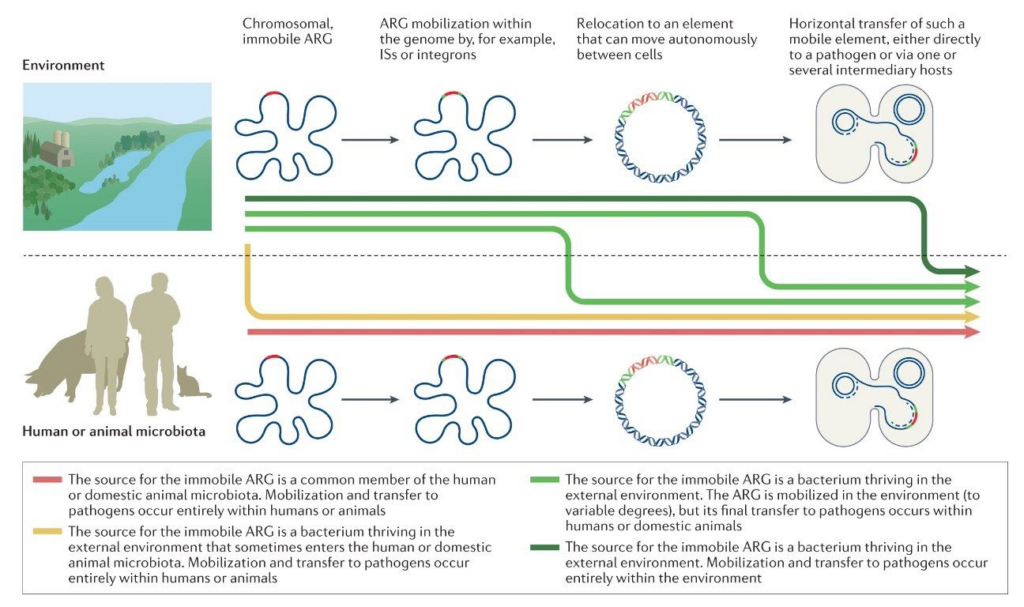prepared by Rémi Gschwind
The AMR digest from November features studies on antibiotic perception, consumption and also how the environment can influence AMR diffusion. Fundamental microbiology linked to AMR is also part of this month digest including subjects such as bacterial cell wall or biofilm. Different environments are also discussed within the papers on natural habitat and animals or water environments. Finally, there’s a special highlight on antibiotic resistance in cancer patient in this “movember” month.
Global
Global antibiotic consumption and usage in humans, 2000-18: a spatial modelling study – Annie J Browne – The Lancet
*This article describes how antibiotic is consumed globally. Thanks to individual level data and geostatistical model they could estimate antibiotic usage and consumption in 204 countries from 2000 to 2018. Beside large increases in the consumption of different classes of antibiotics in several regions, lack of access to antibiotics still seems to be a problem in other regions. Having those estimation, strategies can be thought to adapt the combat against antibiotic resistance increase.
‘They eat it like sweets’: A mixed methods study of antibiotic perceptions and their use among patients, prescribers and pharmacists in a district hospital in Kabul, Afghanistan – Doris Burtscher – PlosOne
What Is the Role of the Environment in the Emergence of Novel Antibiotic Resistance Genes? A Modeling Approach – Johan Bengtsson-Palme -Environmental Science and Technology

Trends, relationships and case attribution of antibiotic resistance between children and environmental sources in rural India – Joseph Mitchell – Scientific Reports
Fundamental microbiology
Colistin resistance in Escherichia coli confers protection of the cytoplasmic but not outer membrane from the polymixin antibiotic – Madeleine Humphrey – Microbiology Society
Microniches in biofilm depth are hot-spots fro antibiotic resistance acquisition in response to in situ stress – Linda Tlili – bioRxiv
The vulnerable versatility of Salmonella antibiotic persisters during infection – Peter W.S. Hill – Cell Host & Microbe
The role of potentiating mutations in the evolution of pandemic Escherichia coli clones – Elizabeth A. Cummins – European Journal of Clinical Microbiology & Infectious Diseases
Phase separation in the outer membrane of Escherichia coli – Georgina Benn – PNAS
Human associated resistome
Metagenomic analysis of microbial communities and antibiotic resistance genes in spoiled household chemicals – Gang Zhou – Chemosphere
Risks of antibiotic resistance genes and antimicrobial resistance under chlorination disinfection with public health concerns – Liping Ma – Environment International
Multidrug resistance dynamics in Salmonella in food animals in the United States: An analysis of genomes from public databases – João Pires – Microbiology Spectrum
Natural Habitat & Animals
Antibiotic resistance in the environment – D. G. Joakim Larsson and Carl-Fredrik Flack – Nature Reviews Microbiology

The myth of antibiotic spider silk – Simon Fruergaard – iScience
Metagenomic strategies identify diverse integron-integrase and antibiotic resistance genes in the Antartic environment – Verónica Antelo – Microbiology Open
Gacier-fed stream biofilmsz harbour diverse resistomes and biosynthetic gene clusters – Sussheel Bhanu Busi – bioRxiv
Water environment & Waste water
Mobilome-driven segregation of the resistome in biological wastewater treatment – Laura de Nies – bioRxiv
Wastewater bypass is a major temporary point-source of antibiotic resistance genes and multi-resistance risk factors in a Swiss river – Jangwoo Lee – Water Research
AMR & diseases
Antibiotic inhibition of the Plasmodium apicoplast decreases haemoglobin degradation and antagonises dihydroartemisinin action – Emily M. Crisafulli – bioRxiv
Antibiotic resistance in the patient with cancer: Escalating challenges and paths forward – Amila K Nanayakkara – CA: a cancer journal for clinicians
*In this interesting review, Nanayakkara and colleagues are discussing the impact of antimicrobial resistance on patient with cancer lifespan. Infection is one of the leading complications in patient with cancer and antimicrobial resistance is related to unfavorable outcomes. Several strategies are discussed to prevent antimicrobial resistant strain outbreak in patient with cancer.